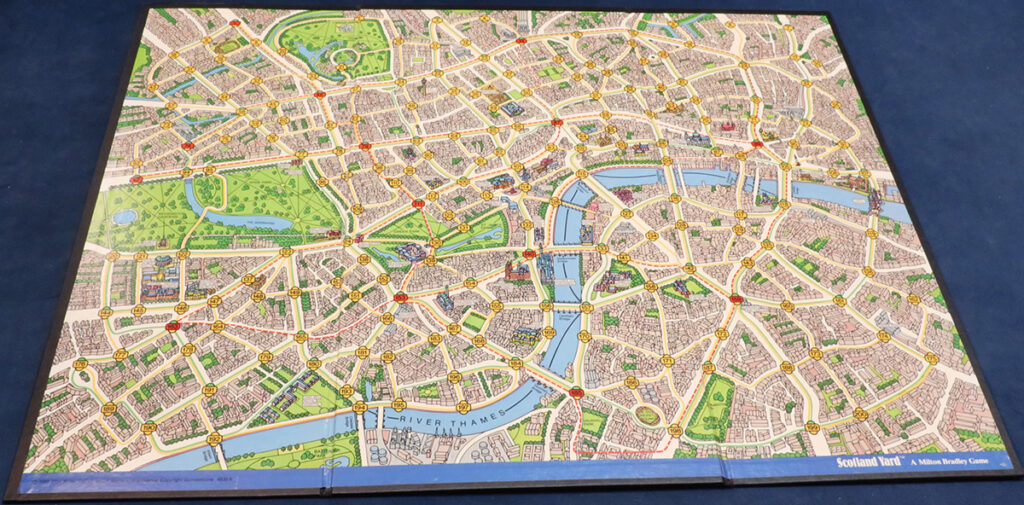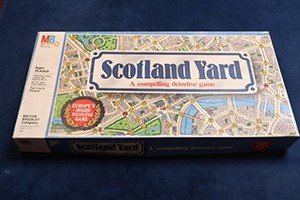
The dastardly Mr. X has struck again! Fortunately, his getaway wasn’t clean, so the detectives of Scotland Yard have a chance to catch and apprehend him before he gets out of central London!
This crack team of up to 5 players must have their 5 detective meeples work together to navigate the winding taxi, bus, and underground routes of the game board in order to locate and cut off this sinister fiend, but with only 22 turns to succeed, Mr. X’s escape is imminent.
How can they possibly succeed with so little time? Let’s take a look at the map setup and rules dossier for Scotland Yard to find out!
How To Play Scotland Yard
Player Count: 3-6
Estimated Play Time: 45 minutes
Scotland Yard Rules PDF
Note: The newer Ravensburger edition allows 2-6 players and tweaks the rules from the older version we’re looking at in this post, which may affect strategies and gameplay a little bit. Make sure to plan accordingly when playing that version of Scotland Yard!
The roads of central London are confusing at the best of times, and the player playing as Mr. X should take full advantage of that, along with his bag of extra tricks, to keep those pesky detectives off his trail.
Scotland Yard’s team has the advantage of numbers though, so by being clever, paying attention to Mr. X’s hints, and working together, they might just capture him before he is able to make his escape!
For both sides to give their best effort in this chase, let’s start by setting up the board and learning how to read the map!
Scotland Yard Setup
Take out the game board and place it in the middle of the table where all players can see and access it easily. You’ll be using it to see where you can go from turn to turn, as well as the current location of all the detectives.
That’s a LOT to take in. Let’s zoom in on a smaller section of the board to learn what all the road lines and colors mean.
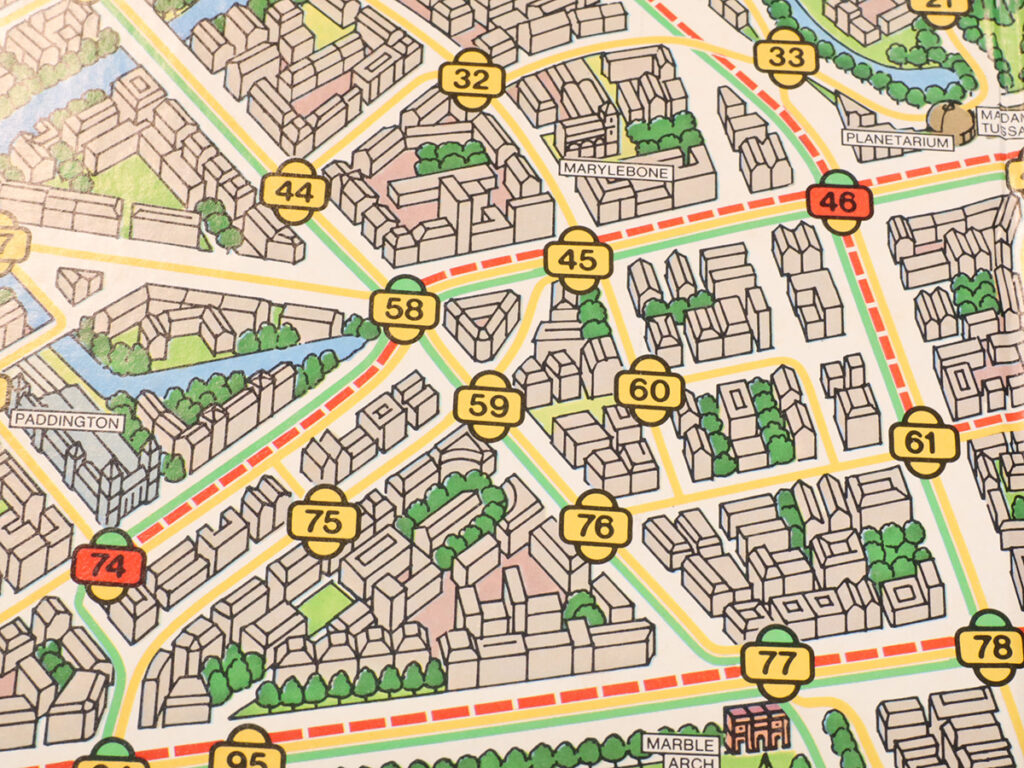
- Solid Yellow lines let you call a taxi.
- Solid Green lines permit you to travel by bus.
- Dashed Red lines allow you to travel on the underground.
You probably also noticed that the stops are either Yellow, Yellow and Green, or Yellow, Green, and Red. This is by design, as these colors are showing you where an entry point and/or stop for your mode of transportation is.
- Taxis can get everywhere on the board, albeit one space at a time, as all numbered locations on the board are Yellow.
- Buses can get most places on the board, though they’ll often skip numbered spots along the way. Look for the Green Semicircle above a number on the board to see if it is a bus stop.
- The Underground has the fewest stops on the board, but is capable of moving great distances between stops. A stop on the Underground colors the surrounding number Red.
- The RIver Thames may only be travelled by Mr. X. Follow the Black Line up or down the river from a connected location to move.
To utilize any of these forms of transportation, you’ll need to spend a matching ticket. During setup, each detective meeple receives:
- 10 Taxi tickets
- 8 Bus tickets
- 4 Underground tickets
Give the remaining 10 tickets to the player playing as Mr. X (4 Taxi, 3 Bus, 3 Underground), as well as the 5 Black Tickets and 2 Double Move tickets (more on those in a bit).
Finally, give each meeple a face down Blue start card. Detective meeples will place their pieces on the corresponding spot of the board. The player playing as Mr. X will not place their meeple on the board, instead making a note of it for their first move.
Note: For Mr. X, it might be beneficial to take a picture of the game board on a phone or tablet so they can easily peruse the board without having to look directly at it, helping them not give secrets away to the Scotland Yard detectives. They’ll still need to watch the board itself to keep track of where the detectives are though!
Mr. X should also find a blank piece of paper to place behind their logbook to serve as a move tracker, as well as a pen or pencil.
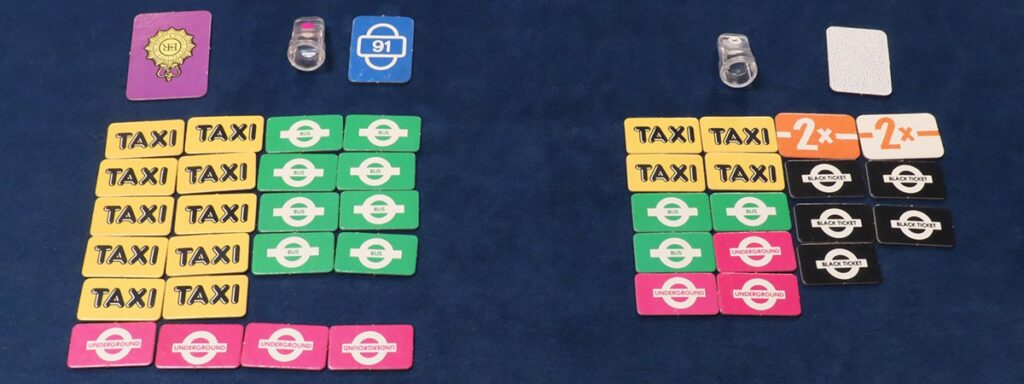
Finally, in the event that you aren’t playing a 6 player game, have the players playing detectives divide the 5 Scotland Yard detective meeples as evenly as possible:
- In a 5 player game, this means 1 player will have control of 2 detectives while everyone else has 1.
- In a 4 player game, this means 2 players will have control of 2 detectives while the remaining player has 1.
- In a 3 player game, this means 1 player will have control of 3 detectives and the other will have control of 2.
Remember, each meeple has its own pile of tickets – no mixing and matching between multiple detectives under your control!
Scotland Yard Gameplay
During a round of gameplay, Mr. X will always move first, then play will pass to the detectives. All players must move on their turn – staying in place or passing is not allowed!
Mr. X’s Turns
Whenever Mr. X moves, he secretly writes down the location he moved to in his logbook (meaning that he doesn’t write his starting location down for the first entry), then covers what he wrote down with the appropriate ticket he used to move.
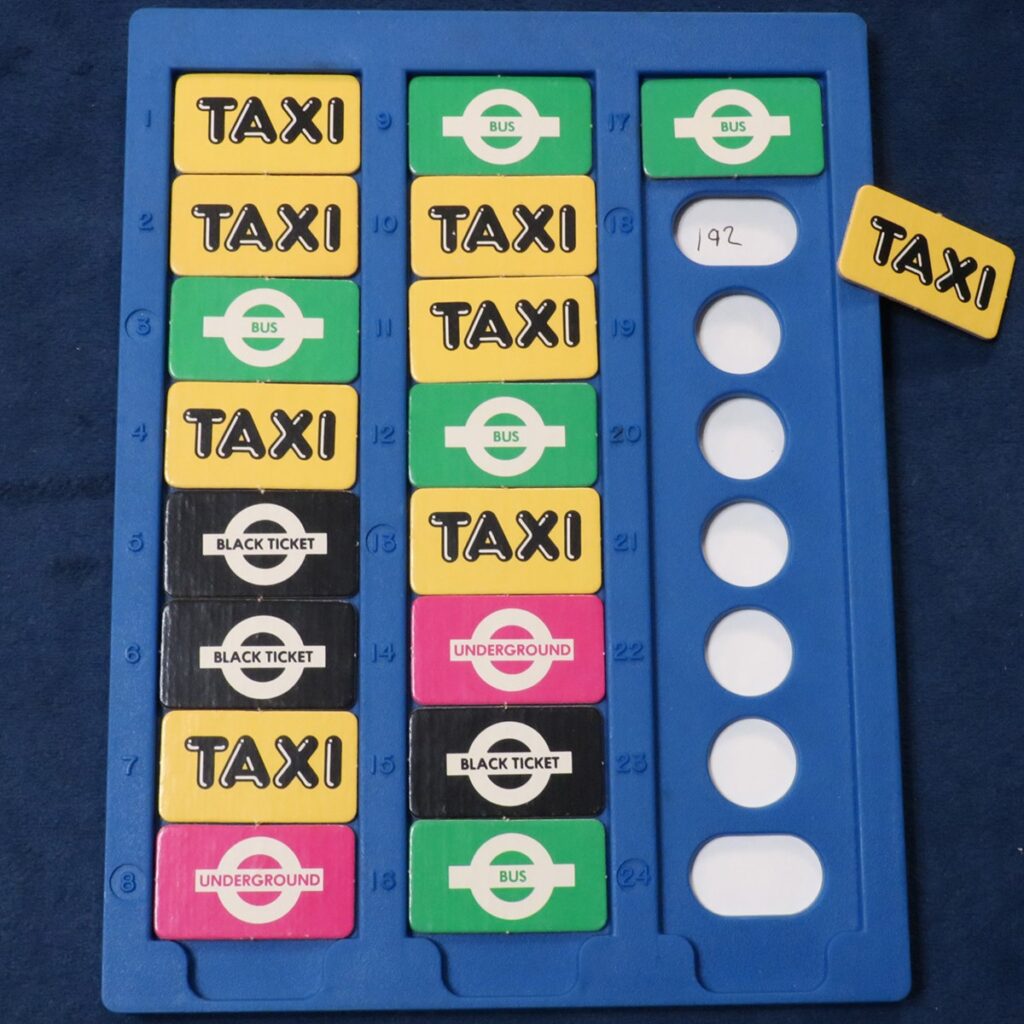
You might also have noticed that entries 3, 8, 13, 18, and 24 are circled. After making these moves in the logbook, Mr. X must “surface” and reveal their location by placing their meeple on the spot they are currently on. That meeple remains in place until Mr. X moves again.
Additionally, the logbook and its ticket history are public knowledge for the detectives, and must remain visible to them at all times.
While surfacing is certainly inconvenient, Mr. X does have a couple tricks up his sleeve to confound Scotland Yard’s finest in exchange for his mandatory taunting.
First, Mr. X may use Black tickets to conceal his mode of transportation for a move in addition to being able to use them to travel on the River Thames. He only gets 5 of these though, so using them wisely is key to evading capture.
Additionally, you might have noted there are 22 moves for the Detectives, but Mr. X has 24 entries in his logbook. That’s where the 2 Double Move tickets come in. By spending one of these tickets, Mr. X is allowed to move twice in one turn. This is perfect for getting out of a potential trap and making a quick getaway.
Mr. X wins the game if one of the following two conditions are met:
- All detectives have made their 22nd move and have yet to land on the same space as Mr. X, meaning they are out of tickets
- All detectives are stranded, lacking the appropriate tickets to move to another space on the board
The Detectives’ Turns
A detective controlling multiple Scotland Yard meeples will move all of their meeples before passing play to the next player. Further, no space on the board can ever contain more than one meeple.
When making a move, detectives give their ticket to Mr. X rather than simply discarding them. This means Mr. X will effectively have an unlimited supply of tickets, though there may be a limit on how many of a specific ticket type are accessible to him at a given time.
Table talk and coordination is also highly encouraged for the detectives – you’ll want to work together to coordinate movements, discuss Mr. X’s clues, and plan the best use for your limited supply of tickets.
If a detective ends up stranded (say, if they only have Bus and/or Underground tickets, but they have no ability to use either where they are) they remain on that space for the rest of the game. If Mr. X happens to bumble into them, they can still capture him!
Otherwise, the detectives win if any of them is ever on the same space of the board as Mr. X, which is confirmed by Mr. X revealing their last entry in the logbook.
Scotland Yard Advanced Rules
Once everyone is comfortable with the basic rules of the game, there are a couple additional rules that can be utilized to spice up gameplay and make chasing down Mr. X even more interesting.
Voluntary Surfacing for Mr. X
Beyond the 5 times Mr. X is forced to reveal himself during Scotland Yard, he may also choose to voluntarily reveal himself after making a move. The rules for revealing himself during a move that isn’t 3, 8, 13, 18, or 24 in the logbook are the same, except he also gets to take one ticket away from every detective of his choice.
This lets Mr. X whittle down the available modes of transportation for the detectives, as well as the number of moves they have available to catch him. Talk about high risk, high reward!
The Detectives Can Cut Off Mr. X
Let’s take a look at the board again real quick before explaining how this rule works.
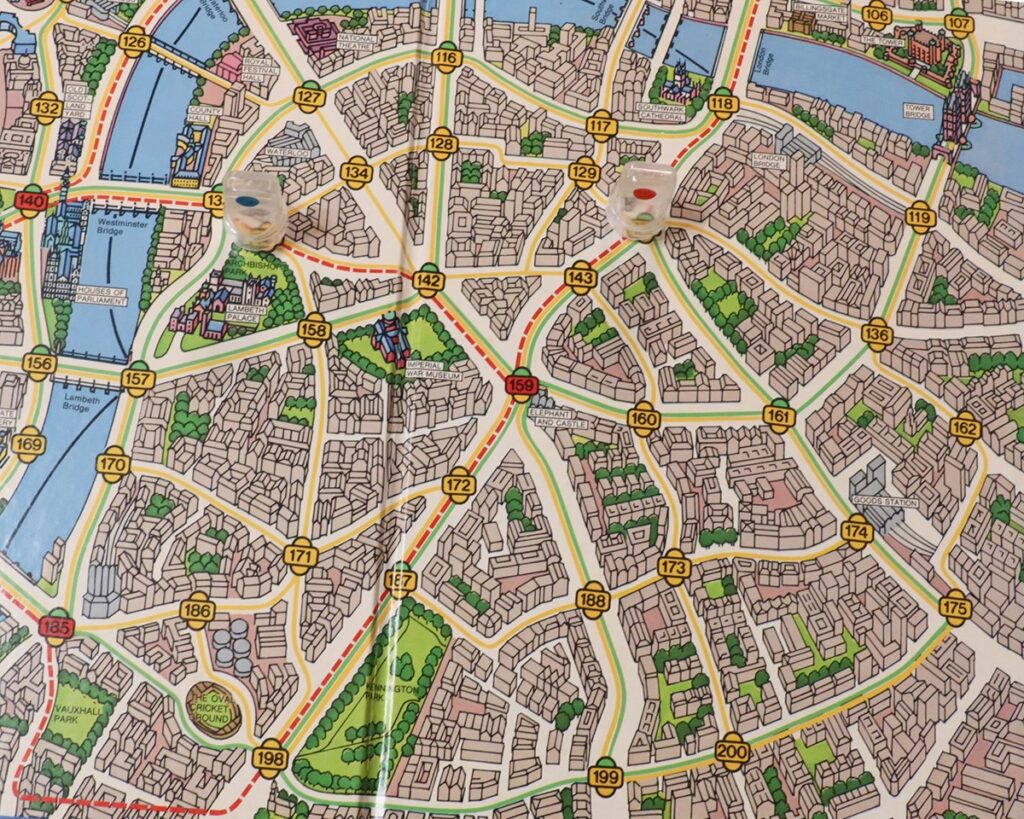
Let’s pretend Mr. X is located at 159, and wants to use the Underground to travel. Under normal rules, he could go northwest to 140, southwest to 185, or northeast to 89 (off screen) with no issue.
As you can see, blue is at 141 and red is at 135 – they’ve figured out Mr. X is nearby and are closing in. With the cut off rule in place, Mr. X is actually forbidden from using a mode of transportation that would take him through another meeple’s space – the detectives are effectively setting up checkpoints to cut off Mr. X!
This means if Mr. X still wants to take the underground, the only route he can take without coming into contact with another meeple is the one going to 185! These checkpoints also only hinder Mr. X – the detectives can still travel through other meeples as long as they don’t land in the same space as another detective.
Scotland Yard Strategies
Page 11 of the Scotland Yard rulebook covers some useful suggestions for both detectives and Mr. X that I’ll also show in the picture below.
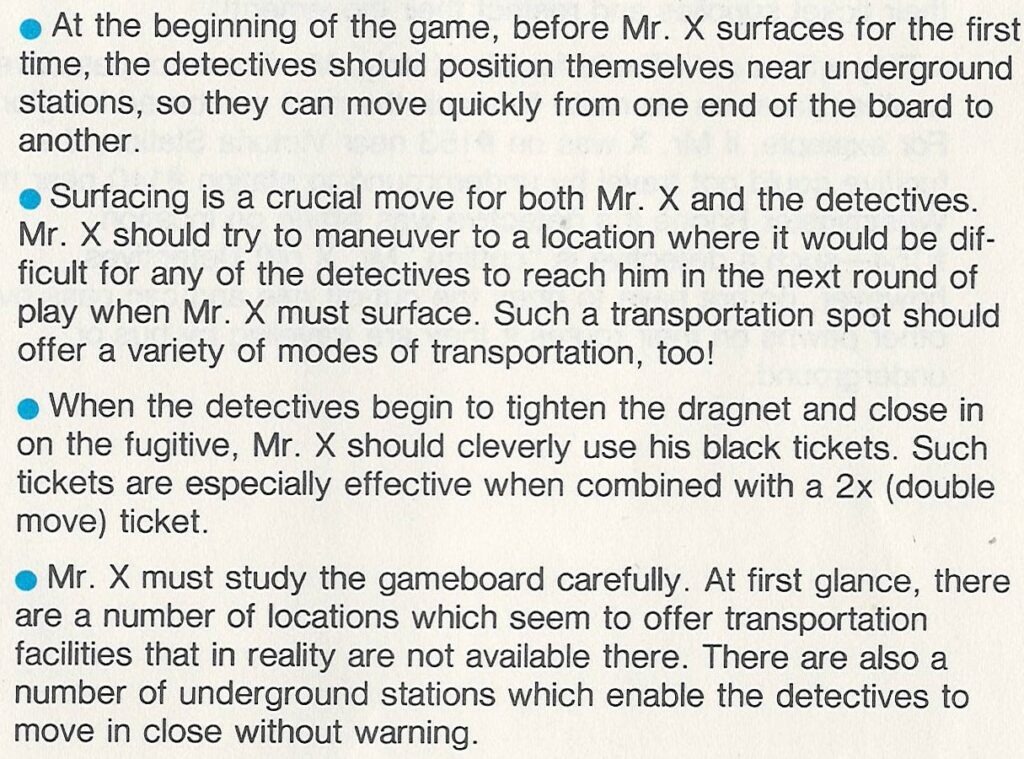
While these are an excellent starting point, I also have a couple tips I want to add.
Double Moves Can Diminish The Usefulness Of Mr. X Surfacing
Since a surfaced Mr. X remains revealed on the board until he moves again, making a surface move the first half of a Double Move ticket can force the detectives to consider multiple possibilities for your location before they get a chance to close in.
You’ll be revealed on the first move, and hidden again on the second – all before the detectives get to move that turn! This is especially nasty if the second half of your move is concealed by a Black ticket.
Such a move is a strain on Mr. X’s limited bag of tricks though – you’ll probably want to save this for an emergency or toward the end of the game if you haven’t found yourself needing to utilize these resources.
The Detectives Should Take Notes
Notetaking is super important for Mr. X’s revealed locations, as human memory is often faulty. This also makes Mr. X’s logbook a very useful tool for tracking him down, as you can consider the different routes he could take and plan your moves accordingly!
Mr. X should also feel free to sprinkle in a black ticket or two if the detectives are doing this, ideally at a location that has lots of possible routes he could go. This can be especially sneaky if he’s somewhere near the RIver Thames!
Pay Attention To The Detectives’ Remaining Tickets
As the game advances, detectives might find themselves without the ability to use one or more modes of transportation. For Mr. X, this will open up additional moves that would otherwise be unsafe. For the detectives, it means they will need to be planning a move or two ahead to ensure they don’t end up stranded before running out of tickets.
Be Mindful Of What You Reveal
For Mr. X, this is pretty self-explanatory. Don’t spend a lot of time hovering over the section of board you’re occupying, lest you give away your position. Take time to examine the board as a whole before deciding on your move, even if there are large portions that aren’t immediately relevant to you.
In the case of the detectives (see what I did there?), this advice applies to table talk. Coordination is critical, but Mr. X can hear and see everything you’re talking about. So if your team comes up with an elaborate plan that will take 4 turns to execute, Mr. X can exploit that setup time with your information to foil you!
Is Scotland Yard A Good Game?
If Scotland Yard wasn’t a good game, it wouldn’t have been around for over 40 years, let alone serve as the blueprint for a whole genre of hidden movement games like Fury of Dracula, Letters From Whitechapel, Nuns On The Run, and Clue: The Great Museum Caper.
Further, I recommend Scotland Yard as an entry point for this type of board game to see if it is your board game group’s speed. Other entries in the hidden movement board game genre tend to add additional mechanics beyond what Scotland Yard brings to the table, which makes learning them a much more complicated process.
As long as you can read a map and strategize, Scotland Yard’s straightforward mechanics will take care of the rest.
Finally, Scotland Yard is very family friendly! Kids can pick up on the “Mr. X is the bad guy, the detectives are the good guys and we need to catch him” angle easily, but it brings a lot more to the table than other introductory entries in Milton Bradley’s catalog, like Candy Land, Connect Four, or Guess Who?, which will be very appealing as they get older and more familiar with board games.
So what are you waiting for detectives? Get your badge and your coat – Mr. X isn’t going to catch himself!
Other Board Game Articles You’ll Love:
- Axe-A-Lot-L Game Review
- Tiny Epic Galaxies Gameplay and Strategies
- CuBirds Gameplay and Rules
- Cindr Board Game Rules and Variants
- How To Play 6 Nimmt
- Blokus Game Rules PDF and Strategies
Braden is a founder of Assorted Meeples and has been a gamer & writer with a vivid imagination all his life. Don’t believe us? Check out his excitement when meeting Goosebumps author R.L. Stine as a kid! An avid Magic: The Gathering spellslinger for over 15 years, you can always convince him to shuffle up for a game (or three!) of Commander.

